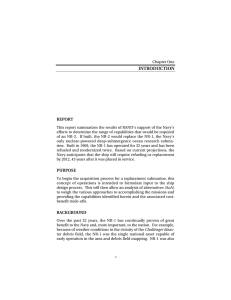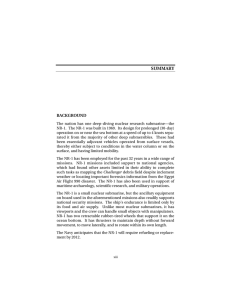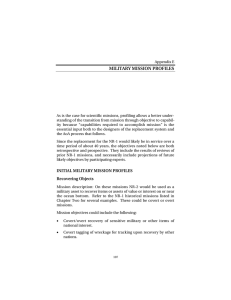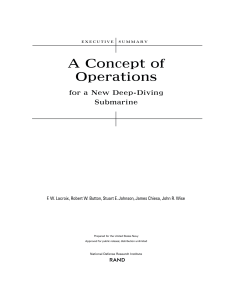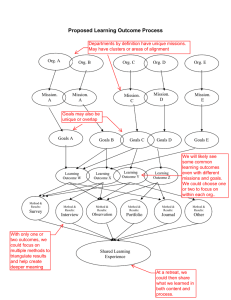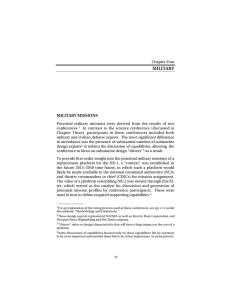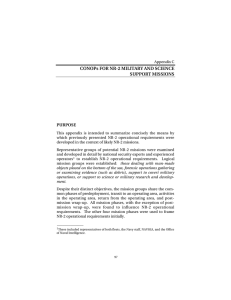CONCLUSIONS OVERVIEW
advertisement
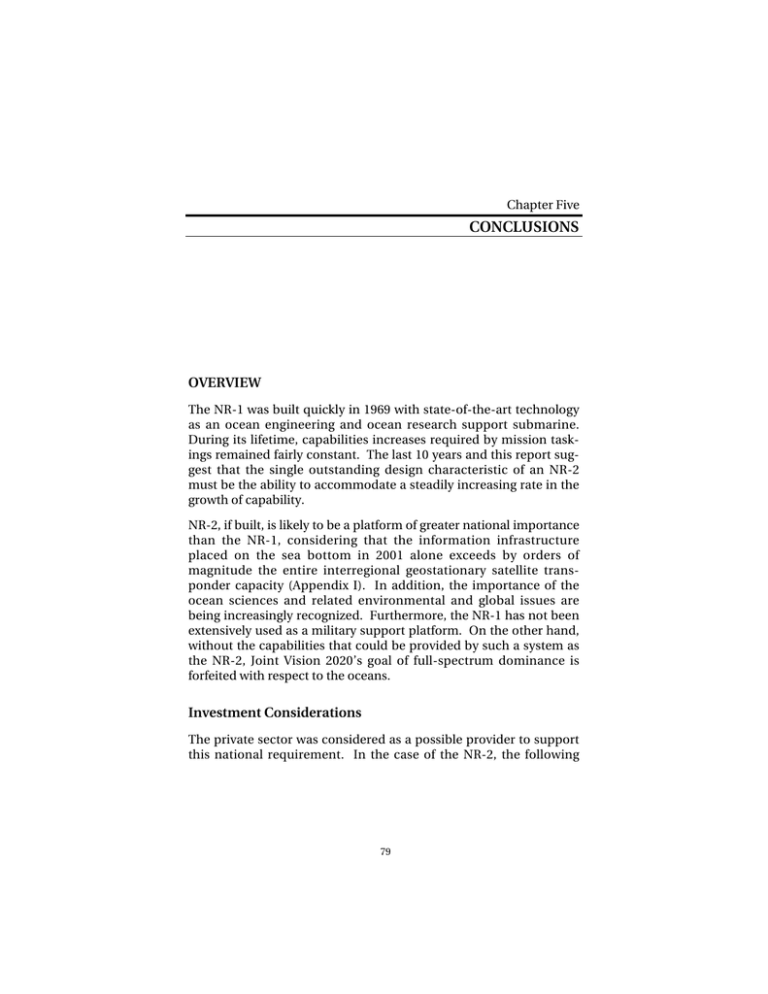
Chapter Five CONCLUSIONS OVERVIEW The NR-1 was built quickly in 1969 with state-of-the-art technology as an ocean engineering and ocean research support submarine. During its lifetime, capabilities increases required by mission taskings remained fairly constant. The last 10 years and this report suggest that the single outstanding design characteristic of an NR-2 must be the ability to accommodate a steadily increasing rate in the growth of capability. NR-2, if built, is likely to be a platform of greater national importance than the NR-1, considering that the information infrastructure placed on the sea bottom in 2001 alone exceeds by orders of magnitude the entire interregional geostationary satellite transponder capacity (Appendix I). In addition, the importance of the ocean sciences and related environmental and global issues are being increasingly recognized. Furthermore, the NR-1 has not been extensively used as a military support platform. On the other hand, without the capabilities that could be provided by such a system as the NR-2, Joint Vision 2020’s goal of full-spectrum dominance is forfeited with respect to the oceans. Investment Considerations The private sector was considered as a possible provider to support this national requirement. In the case of the NR-2, the following 79 80 A Concept of Operations for a New Deep-Diving Submarine statements constitute the preliminary judgment of the RAND researchers: 1 • The private sector will not provide the range, breadth, and depth of expertise and information that the NR-2 will likely be tasked to provide because such an investment would be unprofitable. • Information the NR-2 will provide would not or could not be reliably collected by private-sector or alternative platforms because it would be too operationally or technologically demanding. • The private sector and other platforms would not or could not collect the information the NR-2 could be called on to collect because risk or other constraints would prevent the attempt. • NR-2 will at times be required to provide specific tailored products independently (or combined with other sources) to U.S. agencies (Berkowitz and Goodman, 2000). MISSIONS In terms of missions, this study concluded that the NR-2 should be capable of executing the missions listed in Table 5.1. Table 5.1 The NR-2’s Military and Science Missions Military Science Support Protection of national assets on the seabed IPB Forensics/investigation Expanded ISR Offensive information warfare Defensive information warfare Covert operations Physical oceanography Ice science Geology and geophysics Marine biology Ocean engineering Environmental science Chemical oceanography Atmospheric science Maritime archeology ______________ 1 RAND recommends that the issue of obtaining these required capabilities commercially be further examined in the course of the AoA study. Conclusions 81 CONCEPTS OF OPERATIONS The substantive difference between NR-1 and NR-2 CONOPs stems from the potential increase in the likely demand for NR-2 to contribute to national security (both military and other) requirements over her lifetime in contrast to NR-1. This difference reflects itself in two areas: speed and support CONOPs. In terms of speed, if the NR-2 is to be responsive to both theater and NCA taskings, it must have a higher transit speed capability than the NR-1. In addition, if it is to be used increasingly as a military asset and on occasion employed in covert operations over its lifetime, a recommended “burst” speed capability has also been determined. This speed is adequate to allow clearing of datum for a reasonable period of time in case the OIC feels the situation merits this action. Regarding the support concept, although surface ship support clearly has proven of great merit in past NR-1 science support missions, consideration should be given to designing NR-2 for capability to conduct missions autonomously if higher emphasis is to be placed on military or NCA support missions. The implications and limitations of surface ship consort on covert missions are clear. Support concepts were discussed in Chapter Four. CAPABILITIES Design-Driving Capabilities Two alternative designs for NR-2 emerged from the three NR-2 conferences. Both alternatives would share design flexibility, ample payload capacity, and the ability to operate at depths to 3,000 feet and to bottom. Both would be able to operate an adjuvant vehicle (an ROV/AUV) with a manipulator and would themselves have fine manipulators. Both would have a burst speed capability of 15 to 20 knots. Neither would carry weapons or would have shock hardening, and neither would be designed for under-ice operation. One design concept, clearly preferred in the military conferences, is for a submarine capable of autonomous operations under all conditions. It would have transit speed (15 to 20 knots) to enable timely response to NCA tasking; endurance (about 60 days) to give it useful 82 A Concept of Operations for a New Deep-Diving Submarine time on station; and, for missions in hostile waters, the stealth (stateof-the-art acoustic and magnetic quieting) to avoid undesired encounters. An alternative design concept is for a submarine capable of autonomous operations under all but the most stressing conditions. The concept of an NR-2 working with an SSN escort was preferred to a fully autonomous NR-2 by about a third of the military CONOPs conference participants. The Alternative Design Concept NR-2 would have a transit speed of 10 to 15 knots, about 45 days of endurance, and acoustic and magnetic quieting comparable to the SSN-688. It would be acoustically quiet at low speeds (6 to 10 knots) but might be relatively noisy at higher speeds. It would be designed for SSN tow or “piggyback.” The SSN escort would compensate for the NR-2 level of quieting. This submarine could perform most military missions autonomously. It could, for example, autonomously inspect bottom objects on the U.S. continental shelves. In response to urgent NCA tasking, it could be towed into an AOI, and the SSN escort could recover it after it performed its mission. The SSN would remain in the region as the NR-2 conducted its mission. Table 5.2 summarizes two design concept alternatives’ support for science and military mission objectives for the 16 missions noted. Although the Alternative Design Concept NR-2 is clearly less capable than the Preferred Design Concept NR-2, it would probably be more affordable. Cost savings would come from the following: • Reduced quieting requirements, especially at speeds above 10 knots. • Reduced propulsion plant size reflecting reduced transit speed requirement. • Reduced need for redundancy. • Reduced endurance requirement. The Alternative Design Concept for NR-2 would be capable of conducting science missions autonomously. Both design concepts robustly support the majority of ocean science mission needs. The RAND team acknowledges the support for Conclusions 83 under-ice capability expressed by civilian experts in ocean science and reflected in the body of the report. Absence of under-ice capability is based on the following key points: • The inclusion of under-ice capability requires compromise. Other capabilities would be displaced in this small submarine to accommodate the additional ship control and safety features required for under-ice operations (as a result of the proposed CONOPs, the redundancy needed for operation under the ice will be included in both design concepts). 2 • Arctic capability affects different branches of science to varying extents. Also, current and likely future methods are or will be available to obtain needed information in the Arctic—for example, ice thickness. See Assessing the Benefits and Costs of a Science Submarine (Meade et al., 2001), which provides a good amplifying discussion of the specific capabilities of the submarine to science in the Arctic. • Although many important science missions for the NR-2 could be under-ice, there remains ample science to be supported in the open ocean. Both design recommendations stress the need for the NR-2 to strongly support the widest synergetic selection of science and military missions. • Experts see no current need for under-ice capability for military missions. In stressing missions the Alternative Design Concept NR-2, operating jointly with an SSN, would inevitably be more prone to detection than the Preferred Design Concept NR-2, but the Alternative Design Concept would have the advantage of SSN protection. Also, it is not clear that the Alternative Design Concept NR-2 would be on station long enough for an adversary to have a chance to exploit its greater detectability. ______________ 2 The assessment of relative impacts of specific capabilities on design is outside the scope of this study. RAND recommends that the Navy explore the trade-offs associated with under-ice capability for an NR-1 replacement. Utopia Science Physical oceanography Ice science Geological and geophysical Marine biology Ocean engineering Environ science Chemical oceanography Atmospheric science Maritime archeology Mission 10 10 8 10 10 10 10 10 10 N/A N/A N/A N/A N/A N/A N/A N/A N/A Burst Transit Speed Speed (kt) (kt) N/A N/A N/A N/A N/A N/A N/A N/A N/A 1,000 300 1,000 1,000 1,000 1,000 1,000 1,000 250 N/A N/A N/A N/A N/A N/A N/A N/A N/A R N/A N/A N/A N/A N/A N/A N/A N/A N/A Yes No Yes Yes Yes Yes Yes Yes No Operate AOI Test Acous- Mag on or Speed Deptha tic Qui- Quiet- Near (kt) (m) eting ing Bottom N/A N/A N/A N/A N/A N/A N/A N/A N/A Yes Yes Yes Yes Yes Yes Yes Yes Yes N/A N/A N/A N/A N/A N/A N/A N/A N/A ReposiOffention on sive or Near Under- WeapBottom Ice ons Capability Design-Driving Values Table 5.2 Yes Yes Yes Yes Yes Yes Yes Yes Yes Ocean Interface N/A N/A N/A N/A N/A N/A N/A N/A N/A ✺❁❐❆ 20 30 30 30 30 30 30 30 30 Shock EndurHardance ening (days)b 84 A Concept of Opertions for a New Deep-Diving Submarine 14–18 14–18 14–18 14–18 14–18 14–18 14–18 15–20 10–15d 15–20 15–20 15–20 15–20 15–20 15–20 15–20 15–20 15–20 10 10 8–10 8–10 8–10 8–10 8–10 8–10 8–10 1,000 1,000 1,000 1,000 1,000 1,000 1,000 1,000 1,000 Utopia SOTA SOTA SOTA SOTA SOTA SOTA SOTA SOTA SOTA 688– 688– SOTAd SOTAe SOTAc SOTA SOTA SOTA SOTA SOTA SOTA R Yes Yes Yes Yes Yes Yes Yes Yes Yes Operate AOI Test Acous- Mag on or Speed Deptha tic Qui- Quiet- Near (kt) (m) eting ing Bottom a Given ROV/AUV capability. bOn-station days for science, total days for military. cState of the art. dPossibly greater with support ship tow. e State of the art up to AOI speed. fMilitary endurance requirement can be met with support ship. Military Protect assets IPB Forensics/invest Expanded ISR Offensive IO Defensive IO Covert ops NR-2 concept Preferred Alternative Mission Burst Transit Speed Speed (kt) (kt) Yes Yes Yes Yes Yes Yes Yes Yes Yes No No No No No No No No No No No No No No No No No No ReposiOffention on sive or Near Under- WeapBottom Ice ons Capability Table 5.2—continued Yes Yes Yes Yes Yes Yes Yes Yes Yes Ocean Interface No No No No No No No No No ✺❁❐❆ 60 45f 60 60 60 60 60 60 60 Shock EndurHardance ening (days)b Conclusions 85 86 A Concept of Operations for a New Deep-Diving Submarine Ancillary Characteristics The following ancillary characteristics were recommended for incorporation into NR-2 as a result of the military conferences. 3 While important, they are viewed as not driving design or cost: • Fine-object manipulation (force feedback with plug-and-play variants: ability to operate screwdriver). • ROV/AUV capability. • Adaptable hull fittings for sensors. • Heavy-lift capability. • High-data-rate (HDR) communications capability. • Jetter/dredge capability. • Defensive weapons. • 3-D external viewing capability. • Fine ship position control (on or near the bottom). • Covert communications capability. • State-of-the-art atmospheric control. The following lists include the principal ancillary characteristics recommended for incorporation into the NR-2 based on the science and military missions detailed in Chapters Three and Four. Sensors: • Modest passive sonar • Tactical picture • Defensive actions/evasion • Nonpenetrating periscope ______________ 3 This chapter includes the ancillary characteristics recommended by COMSUBLANT and COMSUBPAC for incorporation into the NR-2. Conclusions 87 • High-resolution sidescan sonar • High-definition laser and optical imaging • Modest signals intelligence add-on equipment optimized for M/F antenna • Accurate long-term bottom navigation • Clip-on external sensor banks. Ship Control: • Improved stability in shallow water • Automatic depth control system (hovering to plus or minus 1 foot) • Ability to control search speed within one-quarter knot • Ability to control angle within one-quarter degree • Improved thrusters for operations in currents up to 3 knots • Buoyancy control in mixed water • Ability to rapidly change ship’s angle and stabilize at communications depth • Ability to rotate within own ship length • Water temperature 28–98 degrees Fahrenheit • Salinity 30–36 parts per million • Ice pick • Emergency propulsion for 220 nautical miles at 3 knots. Communications: • Covert (radio frequency and acoustic) • Multifunction/nonpenetrating HDR antenna. Other: • ROV/AUV capability • Force feedback manipulator with plug-and-play variants 88 A Concept of Operations for a New Deep-Diving Submarine • Improved acoustic and electromagnetic quieting • Externally mounted self-defense system • Ability to dock with mother submarine • Transport via mother submarine or surface, tow speed 20 knots • Bury one-eighth-inch fiber and four-inch coaxial cable • Heavy lift (greater than 10,000-pound capacity) • External keyway mount (10,000-pound capacity) • Limited under-ice—no routine surfacing • Through-hull vertical tube for object deployment • Habitability technology improvements • Selected redundancy improvements • Mission-critical items at least one backup under-ice • Onboard logistics • Power distribution.
